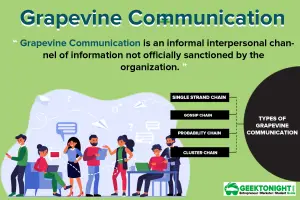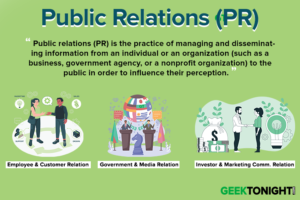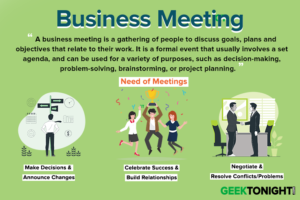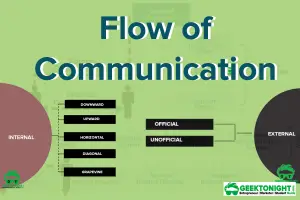What is Barriers to Communication?
Barriers to communication refer to any obstacles or challenges that impede the effective exchange of information between individuals or groups. These barriers can prevent the transmission of messages or ideas, leading to misunderstandings, errors, and reduced productivity.
We find that communication is not effective because of one or more barriers. The barriers to effective communication process are those which make communication ineffective. This may result in either distortion or delay, which are undesirable.
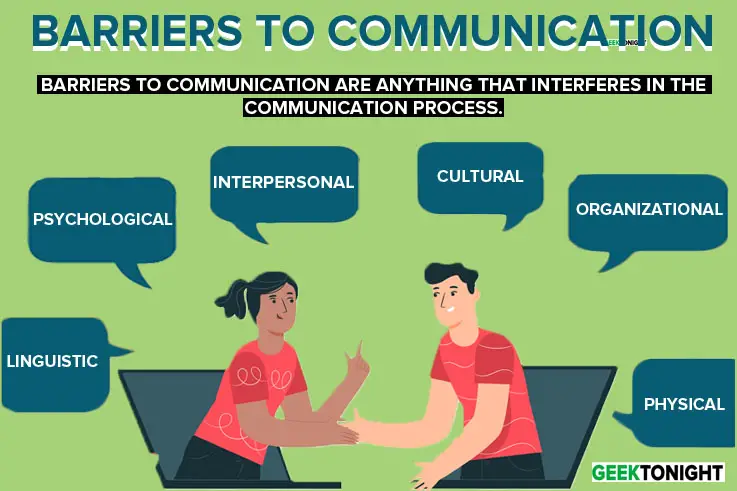
Table of Content
- 1 What is Barriers to Communication?
- 2 Types of Barriers to Communication
- 3 Linguistic Barriers to Communication
- 4 Psychological Barriers to Communication
- 5 Interpersonal Barriers to Communication
- 6 Cultural Barriers to Communication
- 7 Physical Barriers to Communication
- 8 Organizational Barriers to Communication
- 9 How to Overcome Barriers of Communication
- 9.1 Fostering Good Relationships
- 9.2 Purposeful and well focused communication
- 9.3 Coordination between superiors and subordinates
- 9.4 Avoid technical language
- 9.5 Accuracy
- 9.6 Feedback
- 9.7 Clarity in message
- 9.8 Communication of organizational philosophy
- 9.9 Flat organizational structure
- 9.10 Division of Labour
- 9.11 Minimize SemPantic Problems
- 9.12 Organization policies
- 9.13 Proper communication channels
- 9.14 Right feedback
- 10 Causes of Miscommunication
- 11 Business Communication Notes
Types of Barriers to Communication
Types of Barriers to Communication are broadly divided into 6 types, as mentioned below:
- Linguistic Barriers to Communication
- Psychological Barriers to Communication
- Interpersonal Barriers to Communication
- Cultural Barriers to Communication
- Physical Barriers to Communication
- Organizational Barriers to Communication
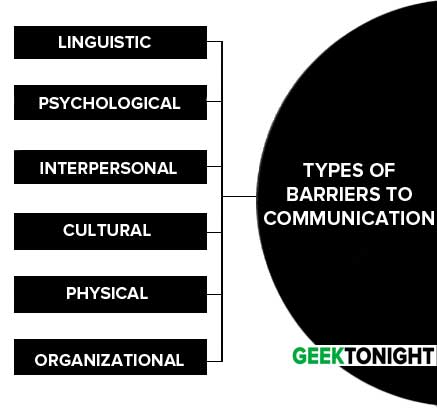
Linguistic Barriers to Communication
Language is the means through which thoughts find expression. The linguistic barriers to communication are described here.
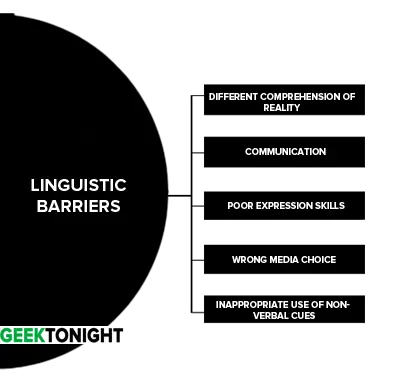
Different Comprehension of Reality
Sometimes the receiver will have a problem comprehending the message. There are number of reasons for this. One is that he may not understand some of the words being used. This is a common problem when a company or industry uses technical terms that have special meaning for them.
For example, in information technology field the term, “burn”, often means “to make a photocopy”; in medical science “OB” refers to “Obstetrics”, while in management studies it means “Organizational Behavior”.
Use of Multiple Meaning Words
Words have no definite meanings. Meanings are attributed by us. A word can have different meanings to different people.
Murphy and Peek say that a small word like ‘RUN’ can have 110 meanings. Words can have different meanings in different contexts.
Therefore, there is a chance for a word used by the sender to be understood differently by the receiver.
Poor expression skills
The communicator should have command of a language to express his ideas or views. Besides vocabulary, one should have knowledge of grammar and punctuation. One should have skills of expression. For example, the use of long sentences and hard words may cause confusion in receivers.
Wrong media choice
There are several media to present information to the audience. Written communication is the best for transmitting rules and regulations. Oral communication is the best to know the problems of a worker. Wrong choices will make communication ineffective.
Inappropriate use of non-verbal cues
Appearance, postures, gestures, time and distance can act as barriers.
- Poor appearance will lower the respect of the sender.
- Wrong postures like leaning on the table may irritate the receiver.
- Too many gestures at a time may make the expression dramatic and the audience may fail to listen to the message.
- A telephone call in midnight may fail to get the required attention.
- Faulty seating arrangements may spoil the discussion.
Psychological Barriers to Communication
The psychological barriers to communication include the following:
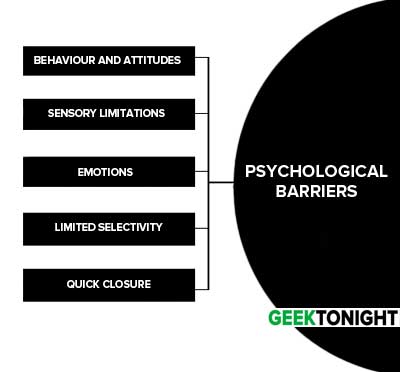
Behaviour and Attitudes
Behaviour and attitude are big barriers in ineffective communication. Every person has different behavior and attitude. If the receiver of the message has similar behaviour and attitude to that of the sender then the response will be positive.
Sensory limitations
The capabilities of sensory organs are limited. We can sense only part of the world around us. Sometimes, we miss what may be important to us. Some people have limited range and power of their senses, whereas some others have very acute and strong senses. As a result, between two people, there will be differences in sensation.
Emotions
If the sender is angry, tense, excited or afraid, he will not be able to send the message properly. Similarly effective communication will also be affected by the mood of the receiver. If his mood is not normal, he will not be able to take the message properly.
Limited selectivity
People select those things which are of interest to them. They ignore such of those things which are unfavourable to them. The selection of message or object thus varies depending upon the selective mechanisms of individuals. The selective mechanisms operate supported by fancies, fantasies, beliefs, like and dislike of individuals.
Quick closure
People tend to close their mind when lose interest in the communication target. The extent of openness or the degree of closure of mind naturally varies from individual to individual based upon the interests and biases of the individuals.
Interpersonal Barriers to Communication
The problems arising in an interpersonal context represent the factors that hinder proper mutual understanding between receiver and sender.
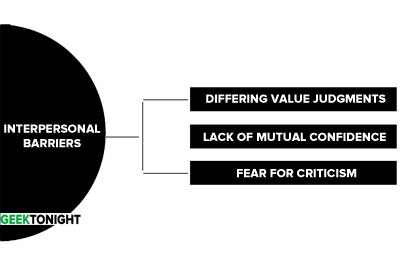
Differing value judgments
Values are what we consider important in our thoughts and actions. The social and cultural values (respect to elders, peace, cooperation, wealth, pleasure, etc.) exercise influence on human beings differently in different contexts. The differences in norms and standards of the individuals result in contradictory opinions among the individuals.
Lack of mutual confidence
If the relationship between sender and receiver is strained, the tone, the language and the very communication is suspected and understanding is made difficult. When a superior says ‘excellent’, the subordinate having sound relationship with his boss will understand it as an appreciation. On the contrary, the subordinate having strained relationship may interpret it as a sarcastic remark.
Fear for criticism
Though criticism is important, many don’t look forward to it. Criticism should be positive. It should not hurt and blow the interest in the job. When a superior adopts criticism for the negative purpose, the subordinate develops apathy or indifference and becomes a poor communicator.
Cultural Barriers to Communication
Cultures provide a framework for people to perceive, understand and evaluate. Culture provides ways of thinking—ways of seeing, hearing and interpreting the world. The same words can mean different things to people from different cultures, even when they talk the “same” language.
Cross-cultural understanding is affected in three ways.
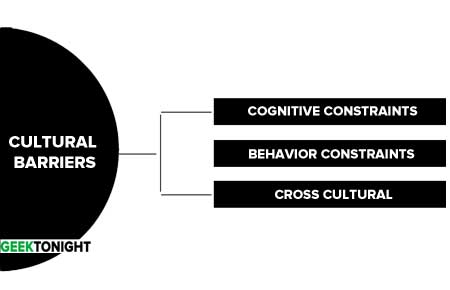
Cognitive constraints
This refers to the mindset or the frames of reference that provide a backdrop that allows or restricts the flow of information. When new information arrives, it is selected, interpreted and understood. This process differs with the cognitive backgrounds of people.
Behavior constraints
This is influenced by values, morals and standards. Each culture has its own rules about proper behaviour which affect verbal and non-verbal communication. Whether one looks the other person in the eye or not; whether one says what one means overtly or talks around the issue; how close the people stand to each other when they are talking—all of these and many more are rules of politeness which differ from culture to culture.
All of these differences lead to communication problems. If the people involved are not aware of the potential for such problems, they may fall victim to them. It takes more than awareness to overcome these problems and communicate effectively across cultures.
Cross Cultural
We will now consider specific cross-cultural communication differences.
General appearance and dress
Americans and Europeans are more obsessed with dress than Asians.
Greetings
American greets with a firm three-to-five pump handshake, standing approximately sixteen inches from the person and steps back to a minimum of two-and-a-half feet. He avoids any other touch.
Mexican greets the visitor with a soft handshake. Then embraces him and pats on the back. He stands very close, touches the elbow and fingers the suit lapels while talking to the visitor.
Japanese bow to greet others. The least status person bows first and displays the deepest bend from the waist, whereas the senior status person bows the least.
Postures
Bowing indicates respect in Japan; Hands in pocket is disrespectful in Turkey; and sitting with legs crossed or showing feet is impoliteness in Ghana, Turkey, Thailand, Saudi Arabia and India.
Facial expressions
Expressiveness differs from culture to culture. Asian cultures moderate facial expression, Mediterranean (Latino/Arabic) cultures exaggerate grief or sadness.
Paralanguage
Loudness is strength or confidence in Germany and Arabic cultures. It indicates impoliteness to the Thais and loss of control to the Japanese.
Chronemics
Time is one of the most central differences that separate cultural attitudes. Novinger calls the United States a “chronocracy,” in which there is such reverence for efficiency and the success of economic endeavors that the expression “time is money” is frequently heard.
This approach to time is called monochronic – it is an approach that favours times appointments and exclusive attention to one interaction. In the East, time has unlimited continuity leading to the view – if not now, later.
People pay attention to many people and many things happening around and this approach to time is called polychronous. This may mean many conversations in a moment (such as a meeting in which people speak simultaneously, “talking over” each other as they discuss their subjects).
Proxemics
Another variable across cultures has to do with proxemics, or ways of relating to space. North Americans tend to prefer a large amount of space, perhaps because they are surrounded by it in their homes and countryside. Europeans tend to stand more closely with each other when talking, and are accustomed to smaller personal spaces.
Physical Barriers to Communication
physical barriers to communication may arise from the environment and transmitter.
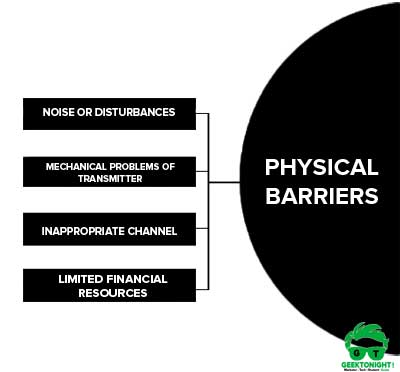
Noise or disturbances
Noise is a major physical and mechanical barrier. The flow of communication is usually blocked by noise. There are many reasons for noise, like human noise, noise due to traffic, the typewriters sound, coolers’ noise, noise in factories, noise due to faulty telephone line or noise due to people coming and going.
Thus, in short, noise is an agitator that disturbs the concentration of the sender or the receiver and prevents them from focusing on the message.
Mechanical problems of transmitter
A poor transmitter may cause noise and adversely affect communication.
Inappropriate Channel
If the medium or channel that has been selected for communication is having problems than communication barrier is created e.g. a snag in the telephone line, telex machine malfunctioning or the mike not working are examples of communication barriers.
Limited Financial Resources
Limited financial resources also create obstacles in the flow of message in a communication process. It is not possible to get all the written material at the communication centre due to financial constraints. Expensive modern techniques also create obstacles in the transmission of messages.
Organizational Barriers to Communication
The organizational barriers to communication are briefly outlined here.
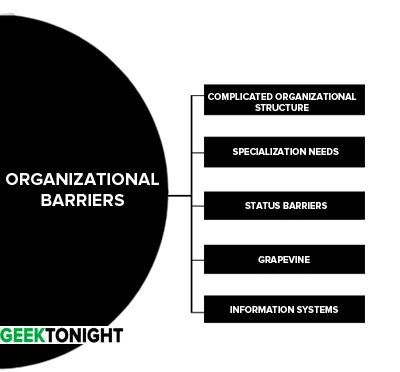
Complicated Organizational Structure
In an organization, communication transmission takes place in the established channels of authority. The source, destination, form and frequency are preplanned.
The communication chain is nothing but the vertical scalar chain of authority relationships. It is time-consuming, and offers little scope to communicate effectively particularly when the hierarchical levels are too many.
Specialization needs
Employees in the organization specialize in different jobs. The specialization poses a serious barrier, because it affects perceptions, language and mutilations.
For instance, a sales manager sees a product as a need satisfier to consumer and expects good quality and reasonable price. A production manager sees a product as a physical item to be designed and fabricated. He may not be as ‘cost-conscious’ and ‘quality conscious’ as a sales manager is. Such differences may lead to misunderstanding.
Status barriers
Communication is affected by status. High status people tend to exhibit ego and authority, whereas low status people experience inferiority complex. These act as barriers to communication.
Grapevine
When the formal communication fails to provide desired information, grapevine takes place. The grapevine is a vehicle for distortions of the truth, rumour and gossip. It may spread incomplete, false or exaggerated information.
Information systems
Systems set up for receiving, processing and disseminating information may at times become stumbling blocks to communication. Manual information systems are slow and sloppy.
How to Overcome Barriers of Communication
How to overcome barriers in communication? Constant work is required to overcome barriers which unconsciously sneak up in the process of communication. Barriers can be overcome if sufficient effort is put into the communication process and it is wanted that communication be effective and efficient.
Following are some of the measures to How to Overcome Barriers of Communication:
- Fostering Good Relationships
- Purposeful and well focused communication
- Coordination between superiors and subordinates
- Avoid technical language
- Accuracy
- Feedback
- Clarity in message
- Communication of organizational philosophy
- Flat organizational structure
- Division of Labour
- Minimize SemPantic Problems
- Organization policies
- Proper communication channels
- Right feedback
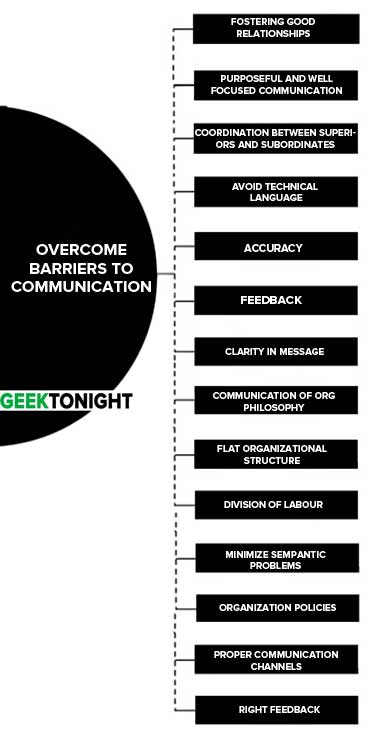
Fostering Good Relationships
Strong relationships must be forged between the employer and employee in order to avoid misunderstandings and accept each other’s view in order to remove the barriers and to help proper communication in the organization.
Purposeful and well focused communication
Communication should be purposeful and aimed at an individual. At the end of the communication, the receiver should not be left to feel that communication had been meaningless or useless.
Coordination between superiors and subordinates
In case, the superior thinks at a level, which is different from that of the subordinate and vice-versa, it will impact the effectiveness of communication. Thus, there should be good and proper coordination and co-operation between the superior and subordinate for effective communication.
Avoid technical language
Specialized language should be avoided. Efforts should be made to use language commonly understood by the receiver and sender of the message. There should be least use of technical jargon in the communication process.
Accuracy
There should be accuracy in the message to be carried between both parties for the communication to improve its effectiveness.
Feedback
The selective percept of receiver should be minimized through proper feedback. The drawback of the selective perception should be explained to minimize the barriers.
Clarity in message
The message to be transferred should be clear, practical accurate and without any equivocalness.
Communication of organizational philosophy
Efforts have to be made in a planned way to sensitize people with the organizational philosophy. It should be properly communicated to its employees so that it allows proper attention in their day-today communication.
Flat organizational structure
The organization should have a clear-cut and simple organizational structure. Tall hierarchical structures should be removed, and changed to flat structures to avert excessive control of information. Wrong information transferred to anyone in the organization can prove detrimental. Proper restyle of organizational structure will trim down the status gap.
Division of Labour
There should be proper division of labour between people in order to reduce information overload and keep delay in information transfer.
Minimize SemPantic Problems
People use either the same word in different ways or different words in the same way. One will be surprised to know that there are 15 different meanings of the word ‘charge’ in the English language. They also occur when people use jargons or professional shorthand which they expect others to understand, or use language that is outside the other’s vocabulary.
Organization policies
The organization should devise its policies in such a way that it will give full advantage to all members of the organization. It should be flexible and easy to implement. While the organization’s goal must be clear, everyone must know about his position in the organizational communication process.
Proper communication channels
If one wants immediate action from the receiver, there is no need to send a lengthy discussion report. One can pick up the telephone or go to his office to tell him what to do. Also remember that a picture is worth a thousand words, and in this age of computer graphics, information can be produced more rapidly in this way too.
Right feedback
Although one-way communication is quicker, two-way communication is more exact. In complex situations, it helps both sender and receiver to measure their understanding and improves their joint commitment towards the task. It alters both parties to describe and clear misunderstandings leading to a higher quality of reception and acceptance.
Thus, in order to communicate effectively, there is need to overcome all barriers and also develop skills to improve existing communication abilities.
Causes of Miscommunication
- Organizational Structure
- Difference in Status
- Lack of Trust
- Incorrect Choice of Medium
- Closed Communication Climate
- Information Overload
- Message Complexity
- Message Competition
- Unethical Communication
- Physical Distraction
Business Communication Notes
(Click on Topic to Read)
Go On, Share & Help your Friend
Did we miss something in Business Communication Notes? Come on! Tell us what you think about our post on Barriers To Business Communication in the comments section and Share this post with your friends.
Business Communication Notes
(Click on Topic to Read)
- What is Business Communication?
- What is Communication?
- Types of Communication
- 7 C of Communication
- Barriers To Business Communication
- Oral Communication
- Types Of Non Verbal Communication
- What is Written Communication?
- What are Soft Skills?
- Interpersonal vs Intrapersonal communication
- Barriers to Communication
- Importance of Communication Skills
- Listening in Communication
- Causes of Miscommunication
- What is Johari Window?
- What is Presentation?
- Communication Styles
- Channels of Communication
- Hofstede’s Dimensions of Cultural Differences and Benett’s Stages of Intercultural Sensitivity
- Organisational Communication
- Horizontal Communication
- Grapevine Communication
- Downward Communication
- Verbal Communication Skills
- Upward Communication
- Flow of Communication
- What is Emotional Intelligence?
- What is Public Speaking?
- Upward vs Downward Communication
- Internal vs External Communication
- What is Group Discussion?
- What is Interview?
- What is Negotiation?
- What is Digital Communication?
- What is Letter Writing?
- Resume and Covering Letter
- What is Report Writing?
- What is Business Meeting?
- What is Public Relations?
Business Communication Notes
(Click on Topic to Read)
- What is Business Communication?
- What is Communication?
- Types of Communication
- 7 C of Communication
- Barriers To Business Communication
- Oral Communication
- Types Of Non Verbal Communication
- What is Written Communication?
- What are Soft Skills?
- Interpersonal vs Intrapersonal communication
- Barriers to Communication
- Importance of Communication Skills
- Listening in Communication
- Causes of Miscommunication
- What is Johari Window?
- What is Presentation?
- Communication Styles
- Channels of Communication
- Hofstede’s Dimensions of Cultural Differences and Benett’s Stages of Intercultural Sensitivity
- Organisational Communication
- Horizontal Communication
- Grapevine Communication
- Downward Communication
- Verbal Communication Skills
- Upward Communication
- Flow of Communication
- What is Emotional Intelligence?
- What is Public Speaking?
- Upward vs Downward Communication
- Internal vs External Communication
- What is Group Discussion?
- What is Interview?
- What is Negotiation?
- What is Digital Communication?
- What is Letter Writing?
- Resume and Covering Letter
- What is Report Writing?
- What is Business Meeting?
- What is Public Relations?


